How to choose a bunk bed for children?

Climbing the ladder to the upper tier of the bed is fun for the child. Preschoolers and adolescents love this type of bed. This makes their room special and opens up new possibilities for play.
Parents are often interested in how to choose a bunk bed for children, so as not to regret buying after the first injury, whether such furniture is comfortable and how soon it will have to be changed. Fears of injury are completely unfounded. A well-chosen bunk bed at the right age will only bring joy to children.
Advantages and disadvantages
A children's room should be comfortable, functional and safe at the same time. And when the room is shared by several children at once, it is important to save as much space as possible for active games.
Ordinary single beds cannot solve such a complex interior problem. Pull-out sofas also do not meet all the requirements. The way out is to equip a bunk bed for children.
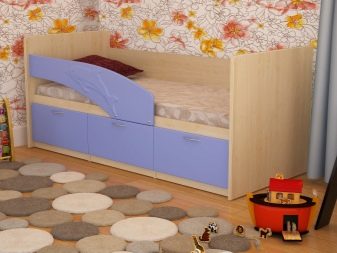
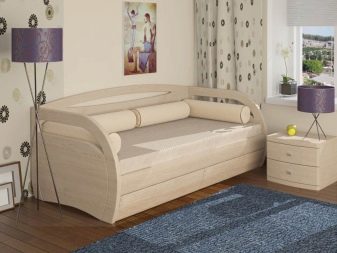
The advantages of bunk beds.
- More living space in the room. A two-level baby bed occupies a vertical space. This is a functional area that continues upward, not in breadth. Due to this configuration, even the smallest room can be made more spacious.
- Visually, the room looks larger.
- One piece of furniture serves several functions. Children love to use the bed off-label. This is their personal space, play area, storage space, and even, despite the objections of moms, the dining area. The design of modern bunk beds takes this feature into account. It often provides drawers for toys, bedding, clothes. An addition can be a table, shelves, movable modules, adjustable lighting, game attributes, wall bars.
- A bed of two floors does not necessarily imply two berths. There are models in which there is only one berth - on the second tier, and the space under it is occupied by a work, play or sports area.
- Children like furniture. It looks unusual, each has its own place. For boys, the bed turns into a fortress or a ship, for girls, into a cozy house or Rapunzel tower. Children's fantasy is unlimited.
- It is safe. A high-quality bunk bed has soft edges, rounded corners, a stable ladder, high sides on the second tier. It is impossible to drop it. It is assembled from non-toxic materials and is supported by durable mounts.
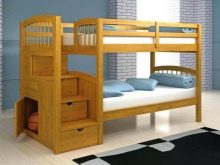
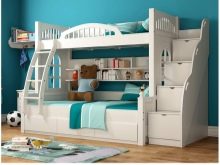
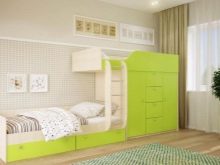
Cons of bunk beds
- Children under 4 years old cannot sleep on the second tier. Pediatricians generally recommend age from 6 years. There is a great risk that the child will fall over playing. During sleep, it is reliably protected by the sides, but parents will have to monitor the activity of the kids during the day.
- It is necessary to ventilate the room regularly and with high quality. If this is not done, it will be stuffy and uncomfortable to sleep on the second tier.
- The bed on the top floor is inconvenient to make. The child, if it is not a teenager, does not have the opportunity to walk along the side and straighten the blanket and bedding. He has to make his bed while staying upstairs. Doing it neatly in this position is more difficult and longer than standing on your feet.
- The cherished second tier becomes the subject of a dispute between children. To avoid conflicts, you need to come up with a fair system for allocating seats.
- It will become more difficult to rearrange the room. First of all, the structure weighs a lot. In the second, according to the parameters and style, the furniture is selected for a specific location in the room. It can be difficult to fit it organically in the opposite corner.
- High-quality furniture with an interesting design - an expensive purchase.
- Good bed can serve for decades, but children will get bored with it faster.

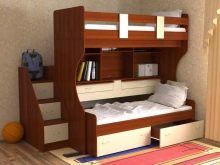
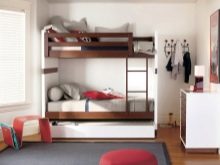
Views
The variety of designs is one of the advantages of two-story beds. Even the most capricious children and the most fearful parents will be able to find a compromise that will match the child's ideas about personal space and meet parental safety requirements.
In order not to get lost in the assortment, two-level beds can be divided into groups: according to the type of design, according to the number of beds, for children of different sexes, for children of different ages.
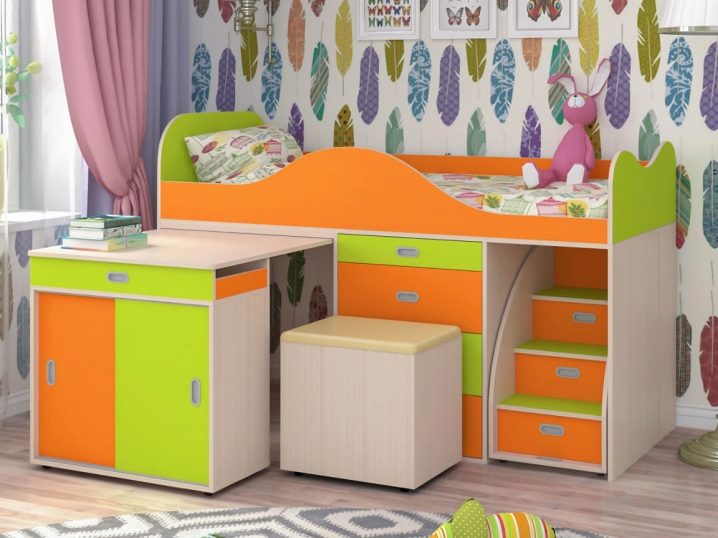
By construction type
There are 4 types: a classic version, a loft bed, a bed with additional functional elements, a transforming bed.
A bed with a solid frame is considered a classic, in which the upper and lower tiers are located strictly parallel. Sleeping places are separate. A ladder with rungs or steps is provided for climbing up.
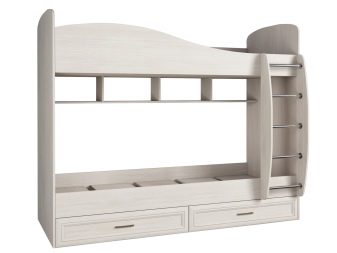
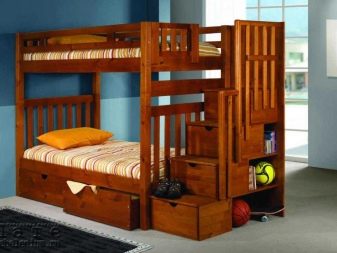
Often there is a classic 2-tier bed in a small modification - when the lower tier is pushed forward. It looks original, but the main purpose of the modified design is not to add originality. According to research by psychologists, a child who constantly sleeps downstairs may feel offended, depressed, less significant. When the top tier does not shade the bottom tier, this problem does not arise.

Also, so that the lower floor does not look less attractive for children, it is worth paying attention to designer bed models. The sleeping places of such a set are combined with additional functional elements and are located not parallel, but perpendicular to each other.
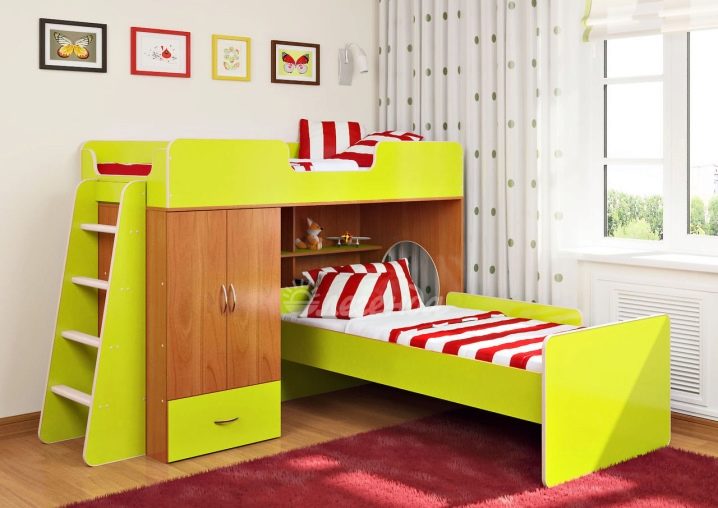
Classic beds on two floors with 2, 3 or 4 berths are free-standing and built into an alcove.
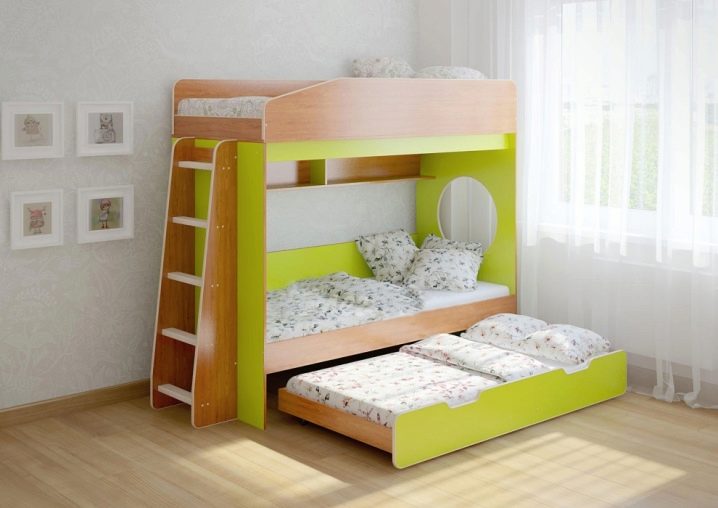
The loft bed is for one person. On the second tier there is a sleeping place, and the first is reserved for a functional area. For preschoolers, this area is usually a play area. A schoolchild needs a work area with a comfortable table and good lighting. If the bed is far from the window, then it is better to organize the working area closer to the source of natural light, and on the first tier to equip a sports or living area or a place to relax.
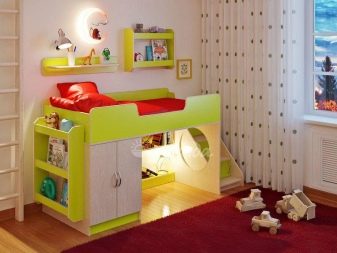
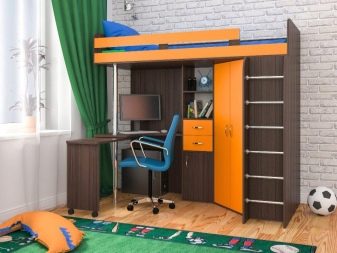
Some furniture factories produce loft beds for two children. Most often these are corner models, in which berths have a common side at the head, and below there are two functional zones.

Loft beds with a built-in storage system are relevant. This arrangement of furniture saves space as much as possible.
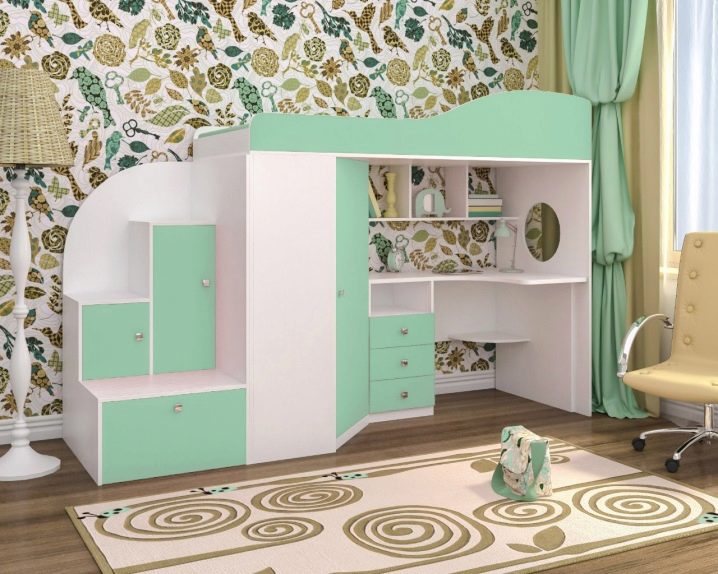
The built-in storage system is one of the optional elements. It can be made in the form of a spacious wardrobe with shelves, a bar for clothes, drawers and baskets for small items.
When there is not enough space for a cabinet in the lower tier area, storage sections are scattered across the hollow compartments of the frame. For example, this is a bunk bed with open shelves, with a narrow pencil case on the side, with stairs and drawers that are located under the steps. A box for storing bed linen is convenient under the lower tier.

On the side of the bed, it will be useful to place elements of the Swedish wall. It will not take up much space, but it will be useful for a child during morning exercises.
Convertible beds are the most numerous type. All of them are equipped with one mechanism or another, which makes it possible to temporarily extend and hide structural details.
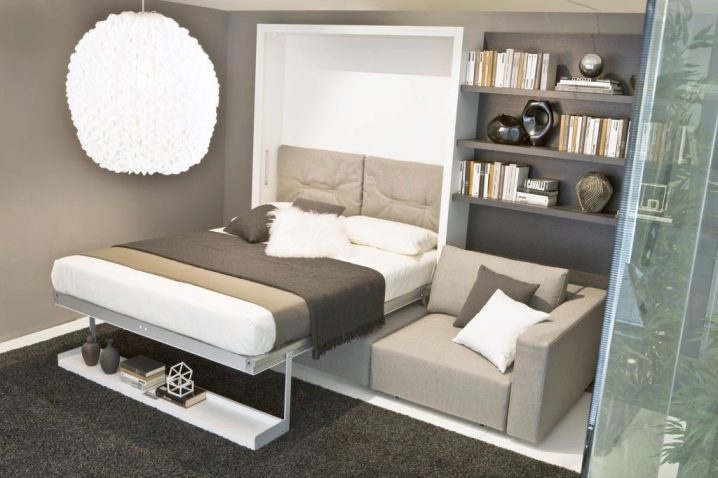
There are only five main types of multi-tiered transformers.
- Roll-out. When folded, such a bed occupies a space comparable to the size of one berth. A simple roller mechanism allows you to make a double or even a triple bed out of it, pushing one tier from under the other.
If the pull-out bed is with a roller mechanism, then the lower tier after rolling out will stand close to the upper one. If the movement is carried out using gel wheels, the structure can be completely divided into two separate berths. In this case, roll the movable part to any distance, like a regular office chair.

Roll-out beds with three levels are the safest, most affordable and practical option for three children.
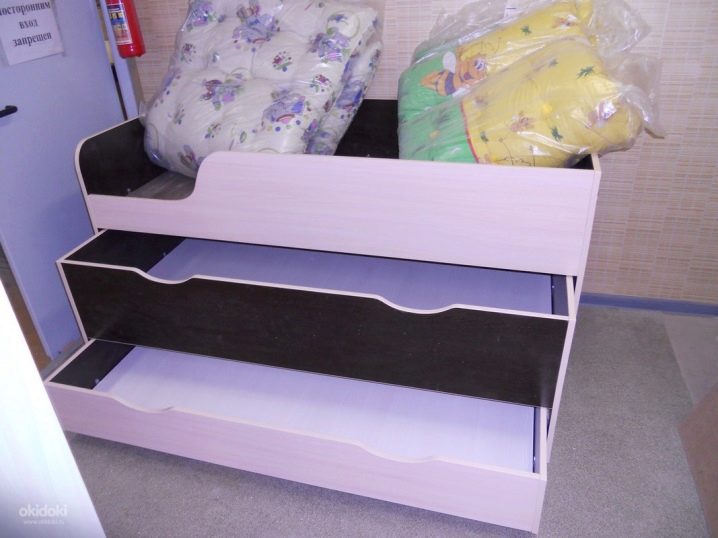
- Sliding. Model of a bed "for growth". The design of the frame makes it possible to increase the length of the bed from 100 to 180 cm. A special mattress must be included with a sliding bed. It consists of soft elements that are gradually added as the length of the bed increases.
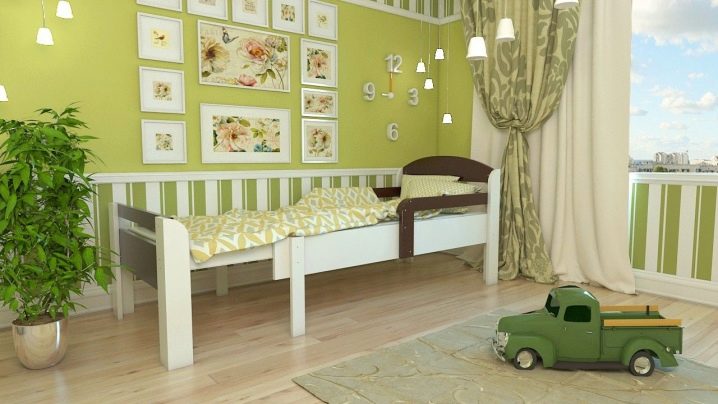
- Foldable. At night, this model looks like a classic bed with parallel berths, and in the daytime it turns into a vertical panel. Compact, lightweight and safe. All parts of the mechanism are located in such a way that the child will not be injured when folding the bed.

- Folding. The folding bed transformation mechanism is similar to the folding one. The difference between the models is that the folding bed no longer performs any functions, and the folding bed provides for a storage system or a work area.
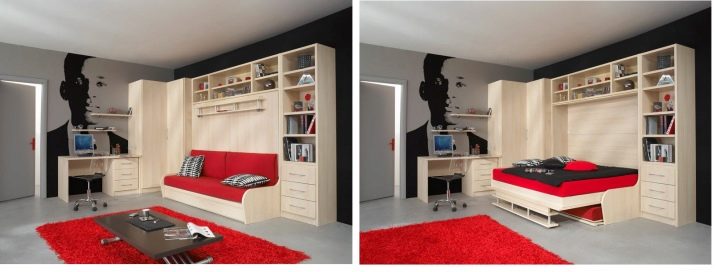
- Modular. This is a furniture set consisting of independent elements. They can be moved, added, removed, combined, optimizing the space in the nursery. Many of the constructor elements are interchangeable.
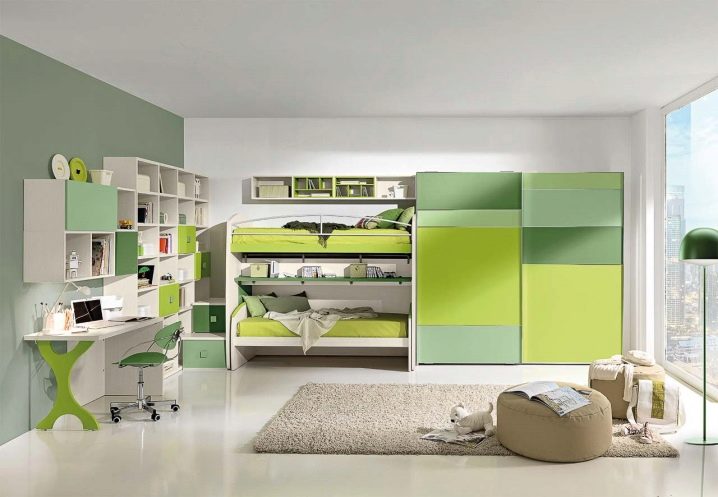
A complex set usually includes one or more sleeping places and additional elements (cabinets, shelves, baskets, drawers). The ladder can be placed in any convenient place and fixed.
A simple suite consists of two berths, which, if necessary, are divided into two bunk beds.
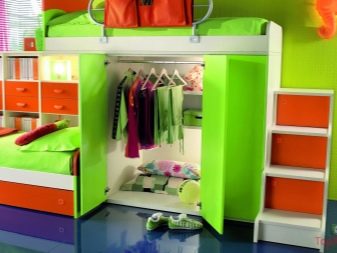
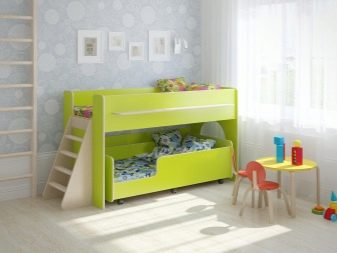
Modern furniture factories provide a selection of finished products and the ability to design custom-made furniture.
By the number of berths
If there are two levels by the bed, there can be sleeping places on it from 1 to 4. Accordingly, the furniture is divided into 4 categories.
- To the first category include loft beds for one child. The dimensions of the bed are variable. For a small room, a single room is suitable. For a spacious room, it is better to choose a bed and a half. For young children who sleep together, double beds are relevant.
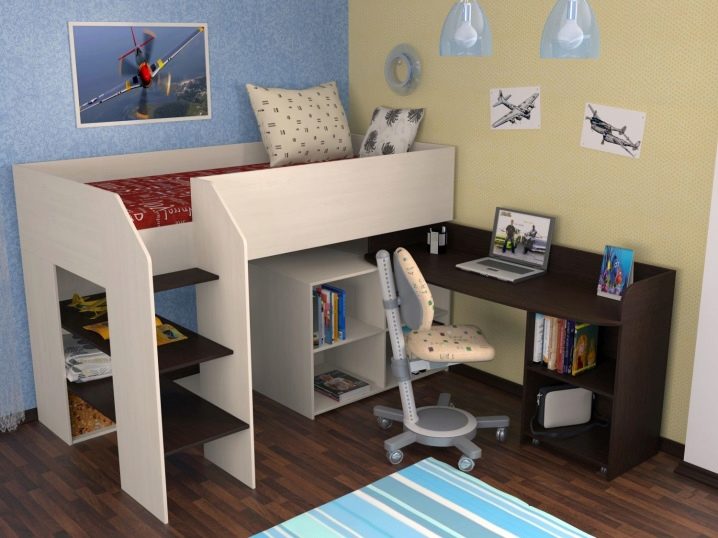
- Second category Are classic bunk beds with a solid frame. They also include collapsible models and transformers with separate beds for two children.
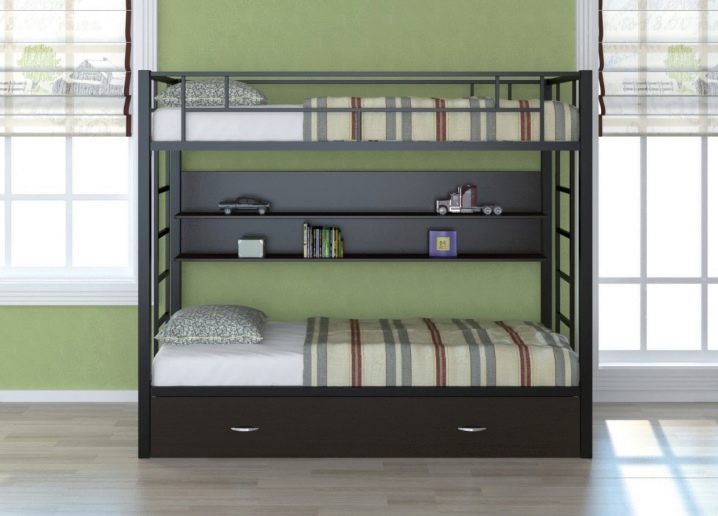
- Third category - beds with three berths. The standard type of triple beds is an L-shaped non-separable frame with two beds upstairs. The third place is located on the first tier and is adjacent to the work or play area.

An L-shaped bed takes up a lot of space, so convertible beds with a pull-out third tier at the bottom are provided for small rooms.

Less common three-level bedswhere all three beds are located one above the other. This model is suitable for a room with a high ceiling, in which teenagers live. The upper tier is located high relative to the floor, and it is not safe to let a preschooler onto such a structure if the bed does not have very high sides.
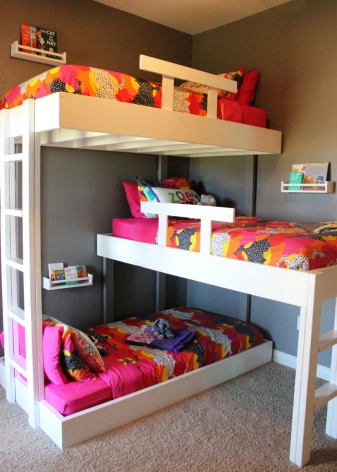
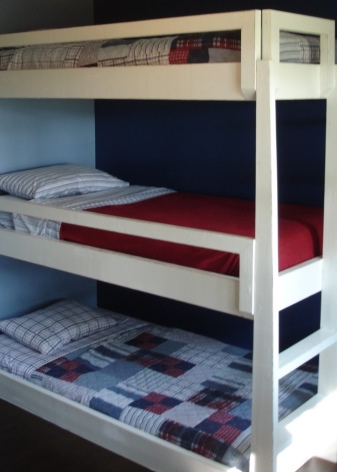
- Fourth category - for large families. The four berths are united by a sturdy frame. Two are located on the first and two on the second tier. These beds usually do not have a functional area.
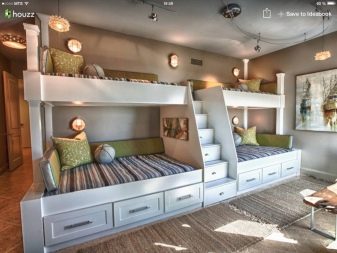
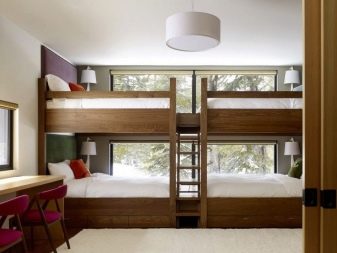
For children of different sexes
A separate room from brothers and sisters is happiness for a child.But for families living in standard apartments, the layout and area of the premises are not designed for this. Children of different sexes often share one room for two, and sometimes for three.
Choosing a bunk bed in a room for a boy and a girl is more difficult than for same-sex children. They have different interests, different wishes and a different pace of development.
Classic models with a solid frame are suitable for children up to 9-10 years old. Taking into account the fact that a baby can be allowed into the upper tier after 4-6 years, and the age difference between children is small, the bed will last about 5 years. Then it is recommended to replace it.
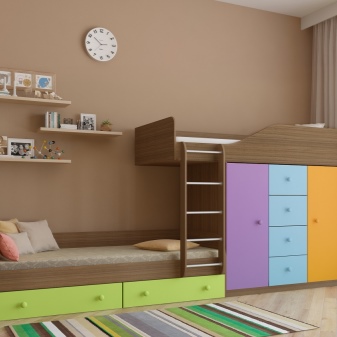
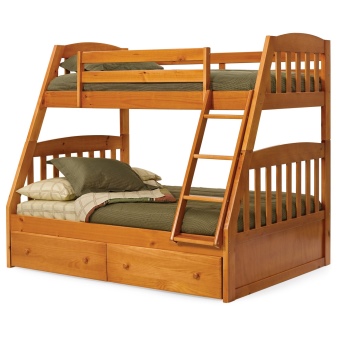
For children of different sexes from 9 years and older, two types of transforming beds are a more practical option.
- Classicalwhen sleeping places one above the other, but with the possibility of dividing them into two separate beds in the future.
- Roll-out bed with a lower tier on wheels. During the day, the structure takes up a space equal to the size of a single bed, and at night the owner of the lower tier can move it to any convenient place.
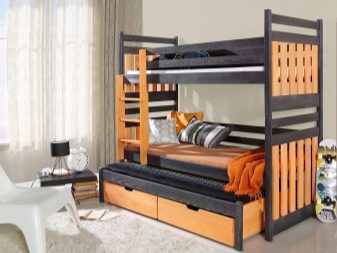
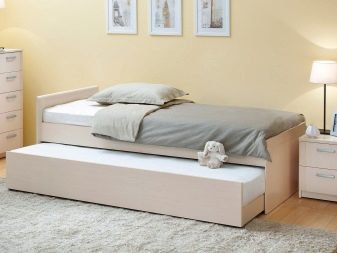
For children of different ages
Quite a lot of time passes between the birth of the first and second child. As a result, children with a difference of two or more years find themselves in the same room. The closer the children are in age, the easier it is to think over an interior that will be comfortable for both. The greater the difference, the more difficult it becomes to organize in one room two spaces that are radically different in function and character.
For preschool age children (from 0 to 5-6 years old), cribs for newborns are comfortable and safe. They come in different configurations, are made in different designs, but all have the same set of characteristics.
Bunk beds for newborns and babies are durable, low, with reliable sides. They take up little space. There are no functional areas for children in the design. They can be equipped with a changing table and lockers for storing baby things, so that parents feel comfortable.
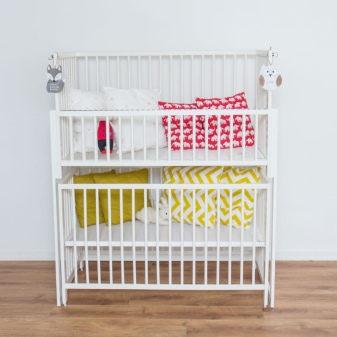
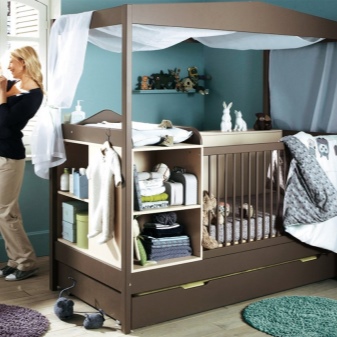
An alternative to such beds is a bunk loft with a cradle below.
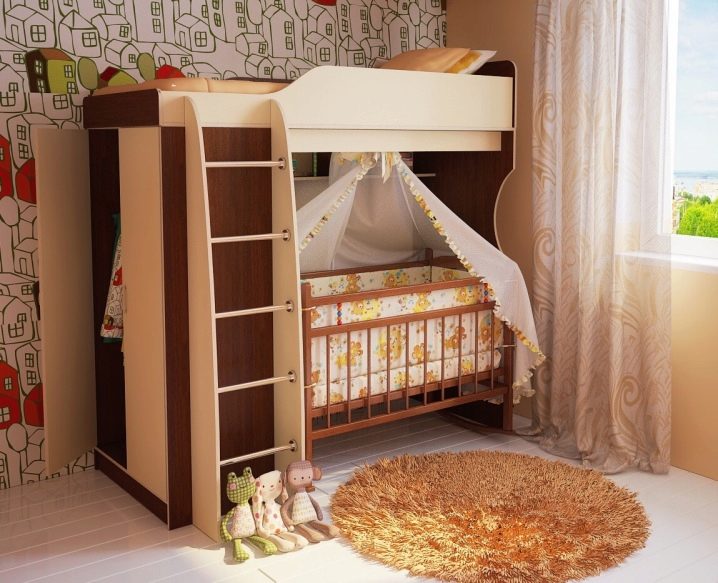
For the younger schoolchild, close proximity with the baby is not suitable. The upper and lower tiers should be at a distance from each other so that the activity of one and the whims of the other do not interfere with healthy children's sleep.
Until the youngest of the children is 4 years old, the lower tier is required. For children over 5 years old, both berths can be placed upstairs.

The most difficult thing is to place a kindergartner or a younger student and a teenager in the same room. To solve the problem, transforming beds are suitable, which can be divided into two independent elements. Children feel comfortable on a bunk bed of a complex design, when the sleeping places are separated by a decorative or functional element.
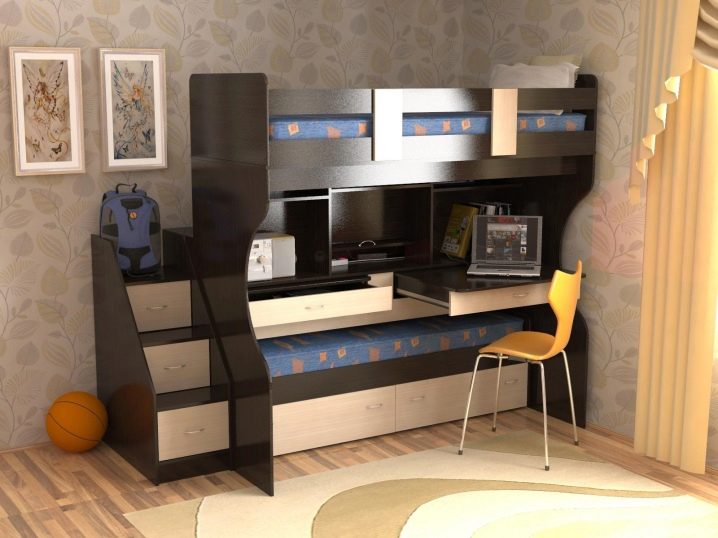
Materials and sizes
Bed design is a matter of taste and aesthetics. The size and material from which it is made is a matter of practicality. The use of low-quality raw materials will shorten the life of the furniture. It quickly loses its appearance, cosmetic defects appear on it. In some cases, they are traumatic.
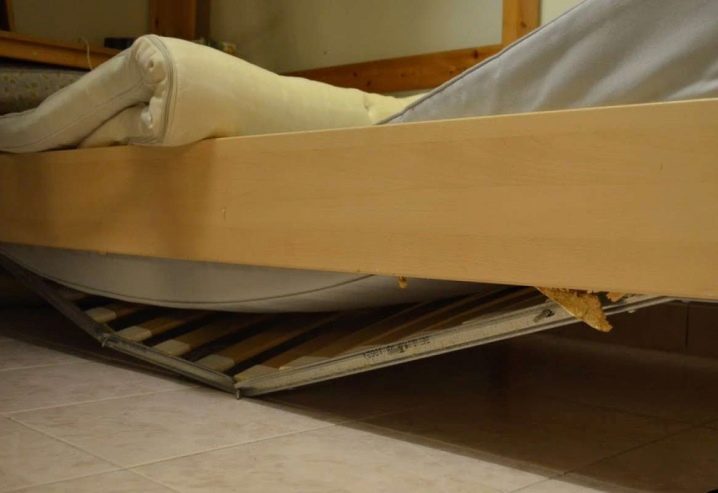
The presence of toxic substances and resins in the composition of raw materials leads to unpleasant consequences. A child can develop various diseases, from allergies to asthma. Healthy sleep on such a bed is impossible. The child will feel tired already in the morning.
Durable frames for children's furniture are made of two materials: metal and wood. They are often combined. Decorative items can be made of plastic and textiles.
Different types of wood are used as materials for wooden structures. More expensive furniture with a long service life is assembled from solid wood. Cheap and temporary models are made from woodworking waste (sawdust, shavings) and natural resins.

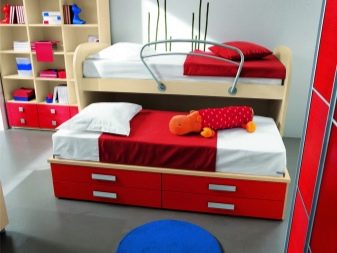
Solid wood beds
- Pine. A significant part of the products on the furniture market are made from pine.It is durable, withstands the playful activity of small owners for years, retains its original appearance for a long time. With minimal decorative processing, a weak coniferous aroma is also preserved. Solid pine is pliable in work. It is possible to assemble a bed of any configuration and complexity from it. It lends itself to various types of decorative processing: wood carving, brushing (aging), burning, painting.

When painted under varnish, the texture of the wood and its color are visible. When using colored enamel, the coating is dense, even and durable.
- Birch. Birch raw materials are cheaper, therefore cribs for children do not require large expenditures. The birch wood bed is also durable and lasts for decades. In the children's room, it is especially good because it is odorless and has bactericidal properties. The material does not cause allergies, and the comfort of the bed guarantees a healthy sleep.
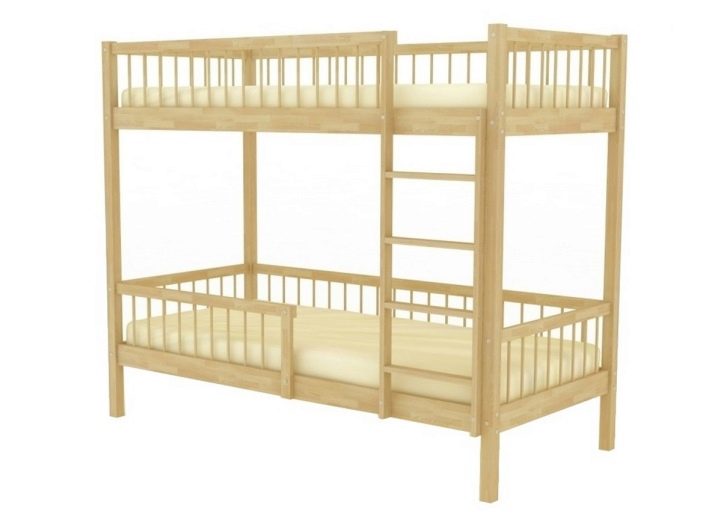
- Oak. An oak bed will serve children, grandchildren and great-grandchildren, it is so durable. However, oak is highly valued in furniture production, so the cost of a bed increases significantly. Oak wood is malleable for chemical treatment. It is often repainted to match other wood species.

- Beech. Its wood is rarely used in the manufacture of children's furniture, but some examples are found under the price tag above average.
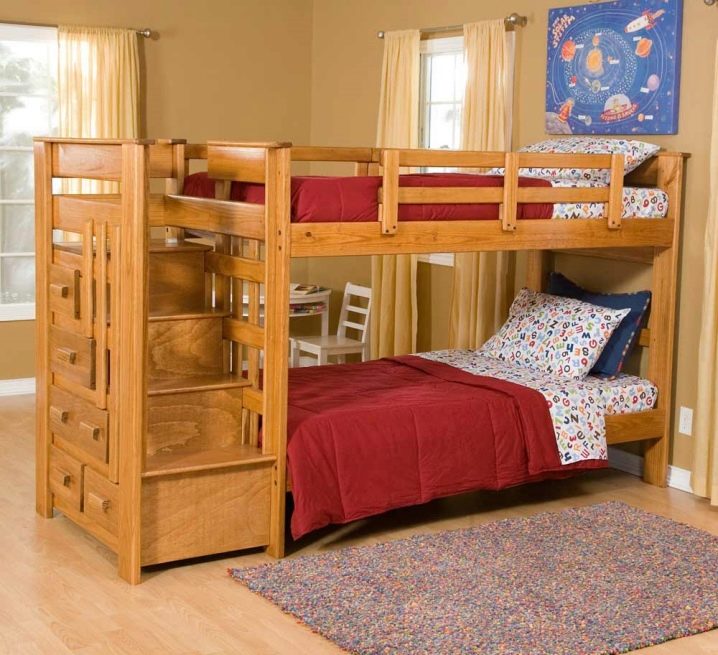
Recyclable wooden beds
- Plywood. This laminated solid wood sheet material is a great budget alternative to expensive furniture. In terms of wear resistance, it is inferior to the massif, but it can withstand ten years of operation in a children's room without difficulty.
It is convenient to make furniture out of plywood with your own hands, cut decorative details of complex shapes, paint and decorate in different ways.
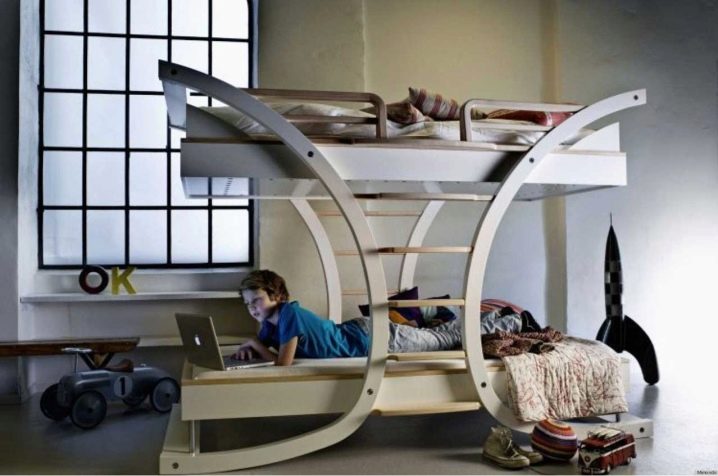
- Chipboard. Thick boards of glued wood shavings covered with laminated film on top are a popular material in the production of children's furniture. Chipboard beds are cheap, varied in design, look nice, do not require maintenance. The laminate can be of any color. It is resistant and does not fade.
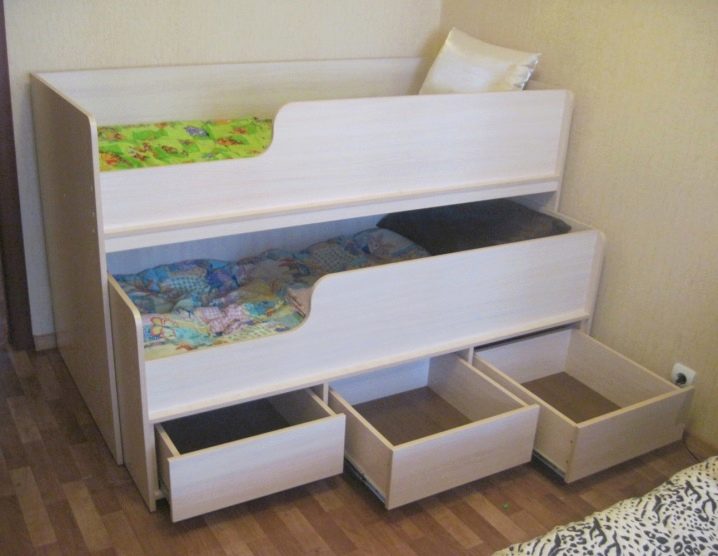
The service life of laminated chipboard furniture is tens of years less than that of solid wood furniture. This is both a minus of the material and a plus. At a very modest cost, laminated chipboard beds can be changed every 5 years, in accordance with the changing requirements of children in their physical development.
Solid wood and recyclable materials together give an optimal result. A bed on a solid wood frame with functional and decorative elements made of chipboard combines the best qualities of materials. It is cheap, looks good, and lasts a long time.
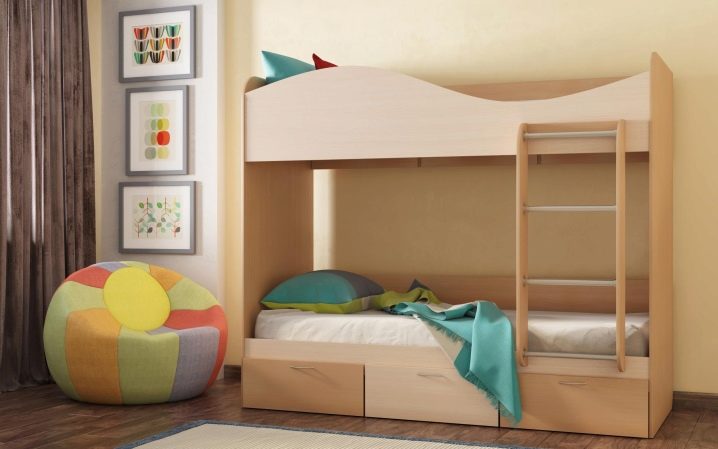
- Metal beds are no less popular... The metal base is durable, resistant to damage, will serve the child throughout childhood. It can withstand not only children's weight, but also the weight of two adults. At the same time, the iron structure is quite light. The frame is assembled from hollow pipes, so it weighs less than a wooden bed made of chipboard. The metal pipes are powder-coated on top. It protects the material from corrosion and scratches. On top of the varnish, paint of any color lays down in an even layer. It can be glossy, matte, glitter or pearlescent.
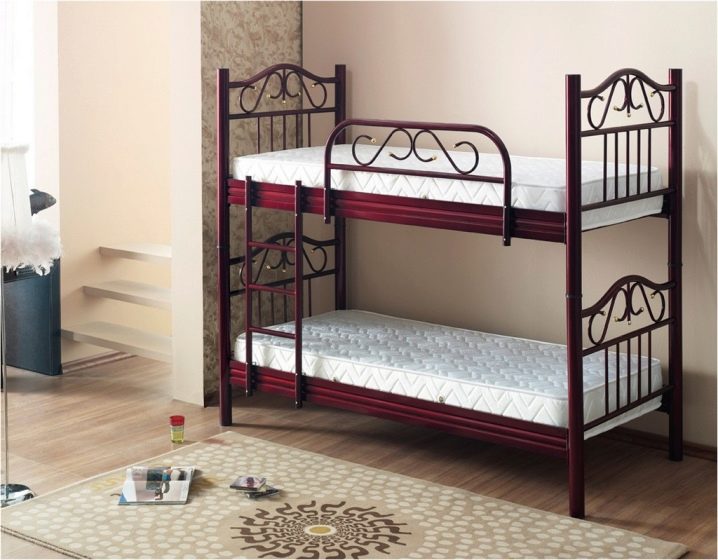
Forged beds are less common. They are expensive, heavy and not always appropriate in the interior of a child's room.
- Some bed models use both wood and metal... Of the non-collapsible options, this is a combination of forged legs and backs with a wooden frame. In the construction of transforming beds, the base is assembled from wood, and the movable mechanisms consist of metal parts.
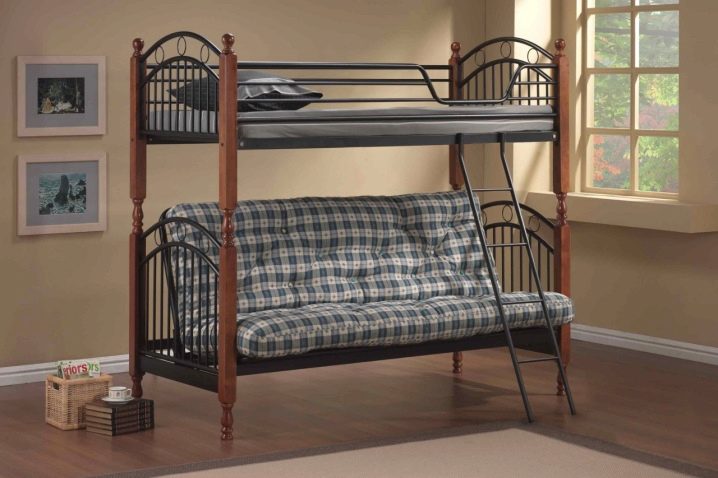
Material and size are interdependent parameters. Solid and wrought-iron beds with a solid frame are expensive, weigh a lot, and are designed for 20 years of service on average. It is better to purchase such furniture for growth, at least 180 cm long. Width does not play a decisive role. Her child can choose independently. The standard size of a single bed is 90-100 cm.If the area of the room allows, it is worth considering one and a half beds with a width of 140-150 cm.

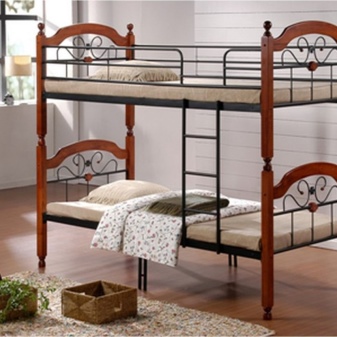
The height of the upper tier depends on the height of the ceilings in the room and the age of the children. A low bed is safer for babies. The upper tier should be located at a height of about 150 cm. For adolescents, any height that the child considers comfortable is acceptable. It is only important to take into account that it is not worth letting the child up to the ceiling. Upstairs it will be stuffy to sleep.
The distance between the berth of the lower tier and the bottom of the bed on the upper one should be large. If an adult can sit up and straighten his back, keeping his head straight, the child will be comfortable there too.
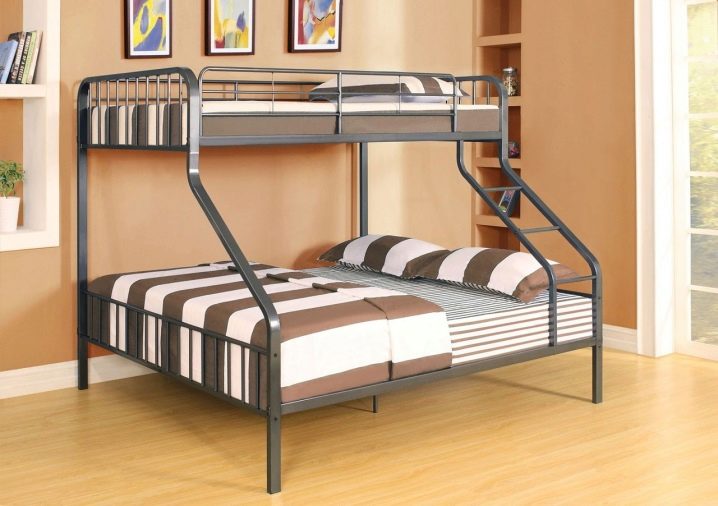
If the apartment has low ceilings, then it is necessary to increase the distance between the tiers without raising the upper floor higher, but lowering the lower one as close as possible to the floor level.
MFC, plywood and hollow tube beds are cheaper and have a shorter average life. Such a bed can be purchased 2-3 times during the growing up of children. The length of the bed for a child under 6 years old is 100-120 cm, for the period from 6 to 10-12 years old - 120-160, for a teenager and a young man - 180-190. Comfortable width - 100-160 cm.
The height is chosen based on the dimensions of the room and the age of the children. Toddlers need a very low model. For younger students, a low one is suitable - about 150 cm. Teenagers are not scared to let on a structure of any height, but it should still have bumpers.
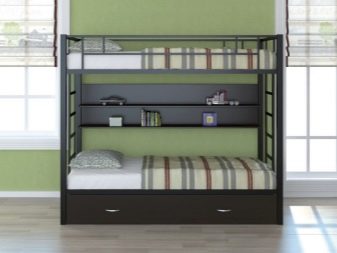
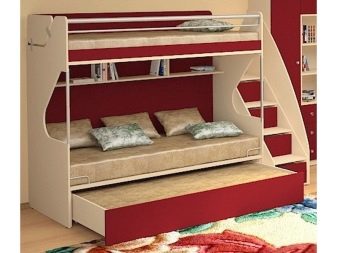
Wooden transforming beds with metal details are present in the economy segment from furniture mass markets and from expensive brands. In addition, they can be ordered according to individual parameters, then the cost will depend on the complexity of the work. An expensive and durable model must be purchased immediately with the maximum parameters of width and length. Sliding, collapsible and roll-out with wheels on the lower tier will do.
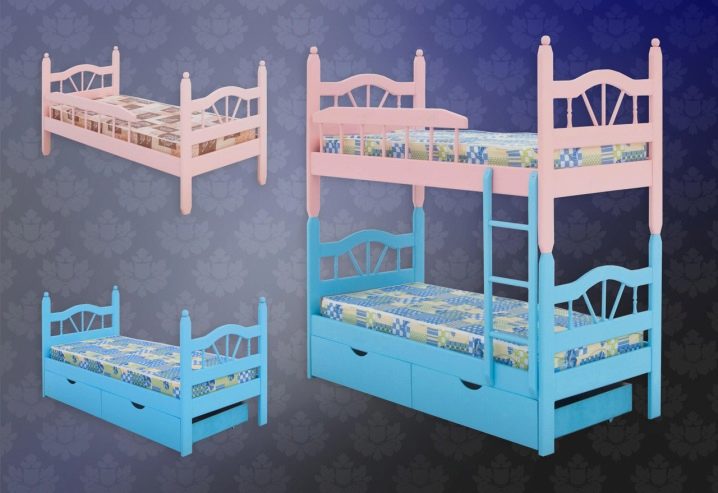
A cheap temporary model is selected according to the same principle as beds made of chipboard and plywood. Any type of transformation is suitable.
Design
Decorating a children's room is a creative process. The main thing in it is to take into account the wishes of the child. If for kids up to 6-7 years old, parents can completely take upon themselves the choice of beautiful and at the same time safe furniture, then older children already have their own preferences.
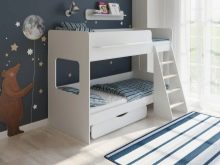
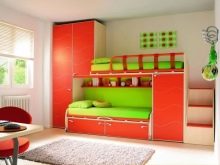
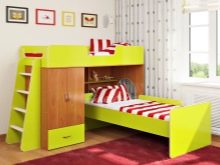
Under the age of 10, children love games, cartoons, bright colors, cute and unusual characters. Boys will love a car bed, a ship or a rocket. Girls love delicate colors, canopies, doll paraphernalia. You can make a bed in the same style for a boy and a girl in the form of a castle. The bus bed will look interesting. Often, children like the marine theme, decoration in the style of their favorite cartoon, the animal world. Children are delighted with the vibrant colors and Native American dwelling decorations.
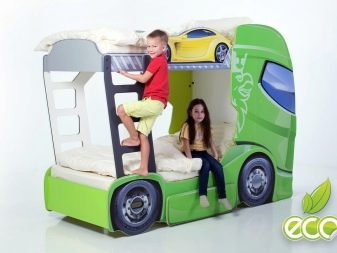
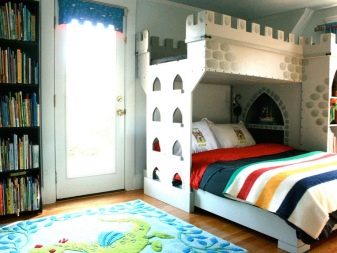
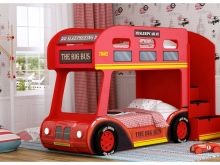

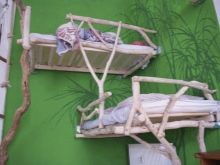
It is more difficult to agree with children in adolescence in tastes. They are no longer interested in cars and Disney princesses. Girls and boys at this age can be addicted to computer games and comics. Their idols live on TV shows and on stage.
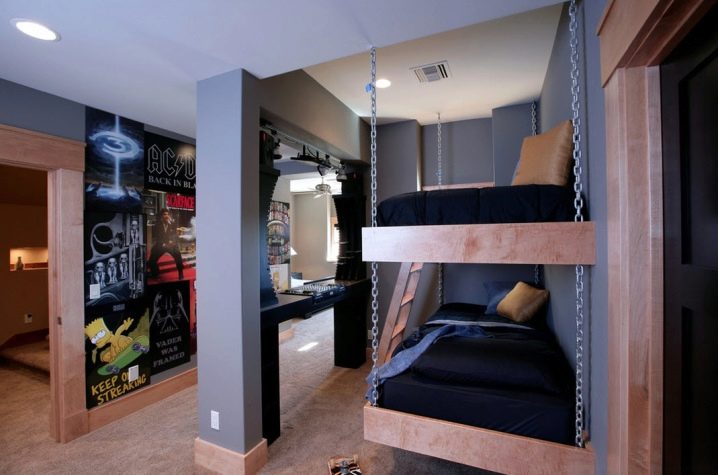
There is no need to refuse a child if he likes a contradictory and rebellious image. If a mother wants to decorate a room in light colors, and the children insist on black beds, a compromise will have to be found.
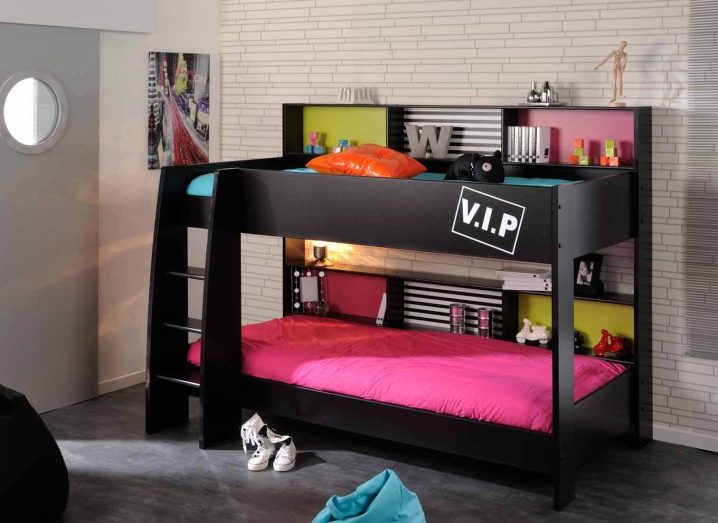
In adolescence, children begin to appreciate the practicality and aesthetics of things. If children have the same interests and hobbies (music, sports, any hobby), they can be taken as a basis when choosing furniture design. Many of them like modern design trends (minimalism, loft) and creative design (hamburger bed, forge in the style of an alien ship, hammock bed).
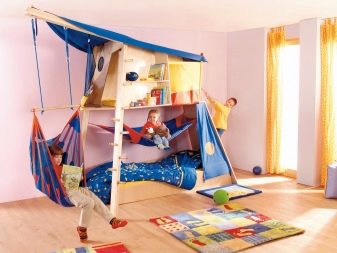
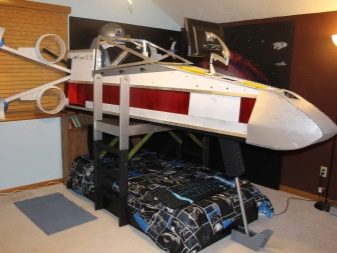
How to choose?
When choosing a bedroom set for children, first of all, you need to evaluate the quality and safety of the product.
Signs of the right bunk bed.
- Reputable manufacturer. An unknown factory can produce decent products, but a factory with a name already has a certain reputation.In order not to lose it, the manufacturer can raise the quality bar, but will not lower it.
- The second reason is the product warranty. A factory that is confident in its furniture always has a longer warranty period than mediocre companies.
- Solid, stable construction made of solid wood or metal. The body parts fit perfectly, the fasteners do not loosen. The base under the mattress is durable, does not bend. Such a bed will support the weight of two adults, and will certainly outlast children's activities during games.
- Smooth and uniform paint and varnish (lacquer, enamel) coating of the bed frame. The thickness must be indicated on the accompanying documents.
- The presence of sides on the second tier with a height of at least 25-30 cm. The height is calculated from the mattress, and not from the bottom. You need to think in advance what type of mattress will be and its thickness.
- Soft edging along the edges of the sides, which protects against impacts.
- Rounded corners, protective rubber pads on protruding corner pieces and fasteners. It is best to avoid protruding metal fittings.
- Stable ladder, wide, flat, non-slip steps. A handrail is optional, but desirable. The child must hold onto something when going up and down.
- Large distance between the upper and lower tier.
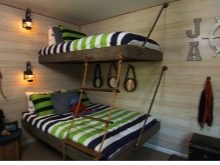
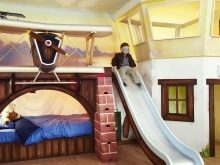
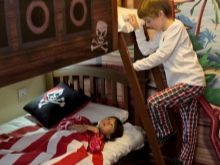
The second step is to think ahead about your child's growth rate and changing interests. Based on such prospects and your financial capabilities, you need to choose a practical model that will not be a pity to replace in 5 years.
The third step is to consult with the children. The uniform interior of all rooms in the apartment looks stylish, but does the child really need a boring wooden bed in the color of hazelnut? Already at the age of 3, the child will easily choose the design and colors to his liking, the parents will only have to fit it into the interior of the children's room.

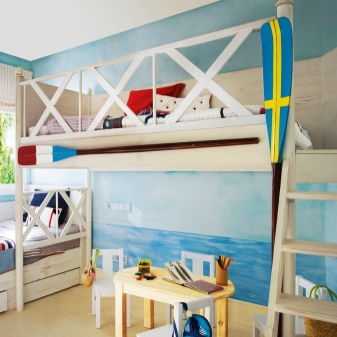
Manufacturers
The choice of a manufacturer who is not afraid to entrust the most expensive depends on the reputation of the company and the budget for children's furniture. For high-quality and inexpensive wooden beds, you should contact a domestic manufacturer ("Legend", "Fairy", "33 beds"). Multifunctional transformers with a guarantee, at an affordable price, with the ability to choose an individual design, will always be found in the stores of the famous Swedish concern. Italian manufacturers have expensive products for little aesthetes. Italian furniture is not only beautiful, but also thought out to the smallest detail.
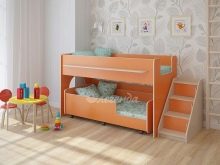
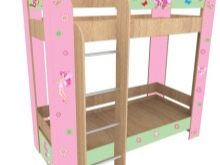
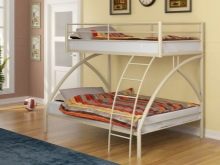
Parents' reviews
Is it safe to let a child on a bunk bed - this is the question that arises for loving parents in the first place. Their opinions on this matter differ. Many people feel that it is better to sacrifice space than to put children at risk. But still, most moms and dads are inclined to believe that a bunk bed in a room is comfortable, practical and delights children. And the problem of injuries and bruises is solved by precautions. If you increase the height of the sides to 40 cm, sheathe the edges with soft material, provide handrails on the stairs and discuss with the children the rules of the game on the second tier, even the most restless child will not suffer.
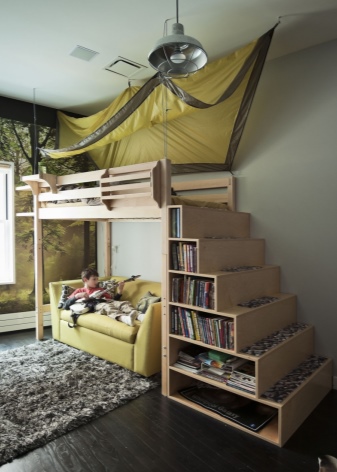
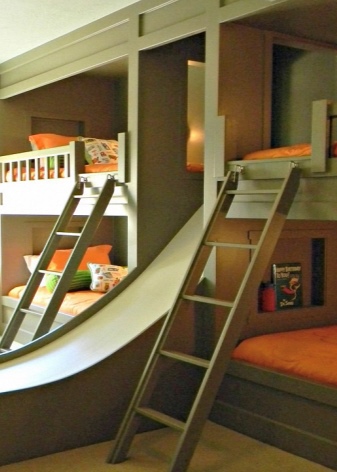
Beautiful examples in the interior
The original bedroom set is a component of the interior. The room will serve as the background for it, therefore, when choosing a design and colors, it is important to take into account the colors of the walls, the design of the window, the design of other objects in the room. For example, the design of a ship bed will be supported by blue, white, gold or emerald colors in the interior, an aquarium, flying translucent curtains or a solid carpet in color.
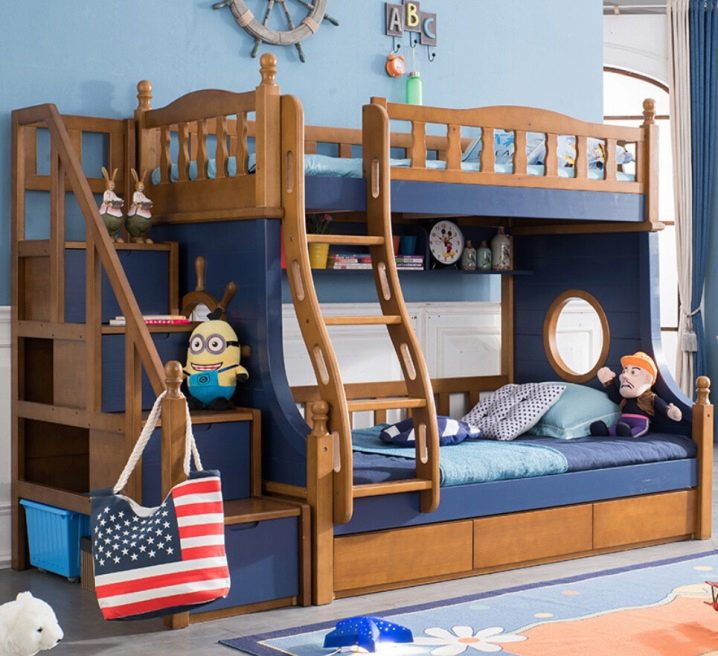
- The medieval castle will organically look against the background of a painted wall, ivy, 3D-theme wallpaper.
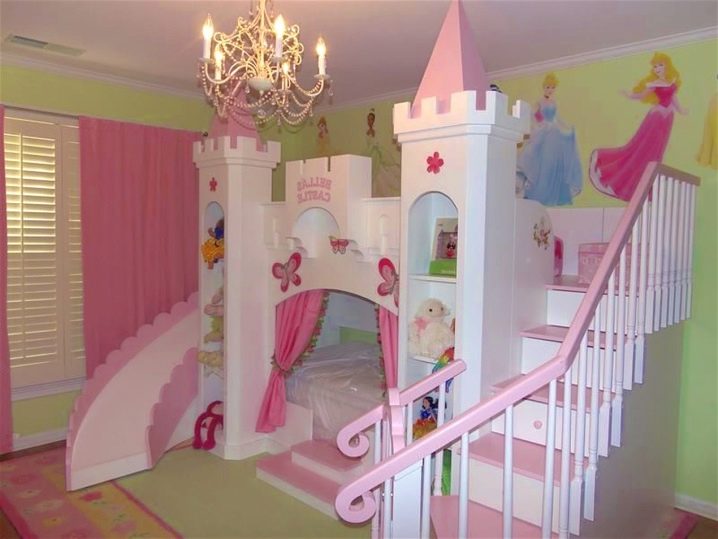
- The bed for two children is well placed not against the wall, but in the center of the room. She divides the space in half, and each child has his own cozy place.
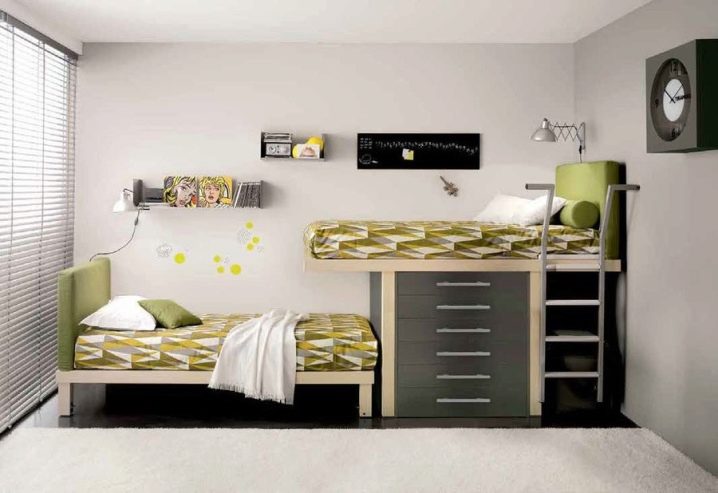
- Small rooms and a non-standard layout will be saved by a transforming bed. A plain bed looks better in a bright interior.On a neutral background, a bed with an interesting design can become the central object of an interior composition.
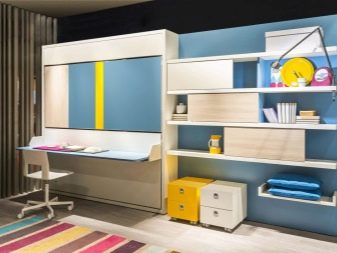
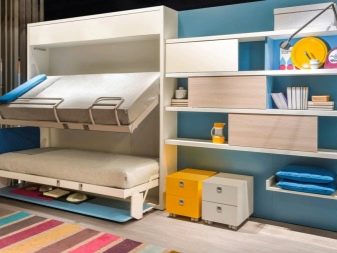
- For lovers of creativity, there are models from untreated wood. They need to be primed and the structure is ready for the little artists to experiment with.

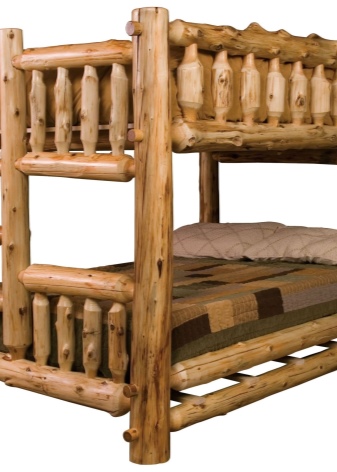
The design of a bunk bed can be interesting or concise, cute or rebellious, but the main thing is that children like it.
Doctor Komarovsky will tell you all about bunk beds for children.













The comment was sent successfully.